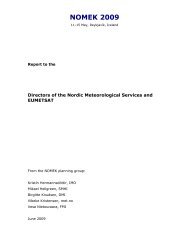International Symposium on Mitigative Measures against Snow ...
International Symposium on Mitigative Measures against Snow ...
International Symposium on Mitigative Measures against Snow ...
You also want an ePaper? Increase the reach of your titles
YUMPU automatically turns print PDFs into web optimized ePapers that Google loves.
<str<strong>on</strong>g>Internati<strong>on</strong>al</str<strong>on</strong>g> <str<strong>on</strong>g>Symposium</str<strong>on</strong>g> <strong>on</strong> <strong>Mitigative</strong> <strong>Measures</strong> <strong>against</strong> <strong>Snow</strong> Avalanches<br />
Egilsstaðir, Iceland, March 11–14, 2008<br />
The effect of avalanches <strong>on</strong> the spatial development of settlements<br />
in Iceland<br />
Harpa Grímsdóttir<br />
Icelandic Meteorological Office, Avalanche Research Center, Árnagata 2−4, IS-400 Ísafjörður, ICELAND<br />
e-mail: harpa (at) vedur.is<br />
ABSTRACT<br />
The planning history and spatial development of Icelandic settlements is discussed in the light<br />
of avalanche history. During the first decades of urbanisati<strong>on</strong> in Iceland, most towns developed<br />
without an official plan. Avalanches had very little effect <strong>on</strong> the spatial development of<br />
settlements at that time, unless they had caused death or great destructi<strong>on</strong>. In the 1920s, the<br />
first planning laws were authenticated. The first plans were an attempt to steer the<br />
development of settlements away from paths of known avalanches. In many cases, the plans<br />
expanded later into known avalanche areas. In the 1960s and 1970s, the populati<strong>on</strong> of many<br />
fishing towns grew rapidly and houses were built closer to the mountains than before. In the<br />
20 th century, up until 1995, there are many examples of houses and buildings being c<strong>on</strong>structed<br />
in the paths of known avalanches within 10−20 years after the avalanche’s<br />
occurrence. In 1985, the first laws <strong>on</strong> avalanche protecti<strong>on</strong> were approved. New laws and<br />
hazard mapping legislati<strong>on</strong> were issued after the avalanche disasters in Flateyri and Súðavík<br />
in 1995. Since that time, estimated avalanche risk, and not <strong>on</strong>ly known disastrous avalanches,<br />
has for the first time had a significant effect <strong>on</strong> the development of towns in Iceland.<br />
INTRODUCTION<br />
The Icelandic nati<strong>on</strong> has always lived with natural hazards. Volcanic erupti<strong>on</strong>s, earthquakes<br />
and landslides have caused great damage. However, snow avalanches have taken the greatest<br />
number of human lives through the centuries, when fatalities due to storms at sea and<br />
wilderness areas are excluded. During the first centuries after the settlement of Iceland, the<br />
greatest number of avalanche victims were people travelling in the mountains. After the<br />
urbanisati<strong>on</strong> began during late 19 th century, most avalanche victims in Iceland have been in<br />
houses or working places. In this paper, the effect of avalanches <strong>on</strong> the spatial development of<br />
villages in Iceland is discussed. The c<strong>on</strong>clusi<strong>on</strong>s are partly based <strong>on</strong> comparis<strong>on</strong> of avalanche<br />
maps of Icelandic villages to maps made by the Icelandic Meteorological Office (IMO), that<br />
show the building years and locati<strong>on</strong> of houses and buildings in towns where avalanche<br />
hazard is significant.<br />
THE FIRST DECADES OF URBANISATION IN ICELAND<br />
Iceland was settled in the years 870−930. Most farms in the mountainous regi<strong>on</strong>s in Iceland<br />
were located close to running water and, therefore, often beneath gullies. The houses were turf<br />
houses that did not last for very l<strong>on</strong>g and they were rebuilt and even relocated a bit quite<br />
frequently. As a result, it seems like the farms often ended up in the best possible locati<strong>on</strong><br />
Grímsdóttir 157











